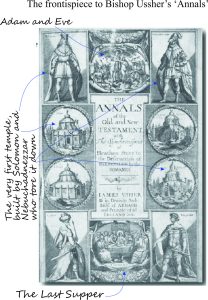[I had the opportunity to browse some of Ussher’s notes and scribblings during a visit to Trinity College, Dublin – A chance encounter with Bishop Ussher – or how I caught up with him]
In 1650 AD/CE, James Ussher, Bishop of Amargh and Primate of all Ireland, published the scholarly “Annals of the Old Testament, deduced from the first origins of the world” where he concluded that the universe, and everything in it, began at noon, October 23, 4004 BC. To many modern scholars of the earth, this seems outlandish, even ridiculous. Creationists though still attest to its veracity.
It is easy to fall into the trap of judging old ideas with modern concepts and proofs, rather than judging them according to the precepts and traditions of their day; of course, the real kicker here is that one needs to have some knowledge of those cultural contexts and traditions. I was reminded of this during a re-read of Stephen J. Gould’s Fall in the House of Ussher (Natural History, 1991). In an early paragraph Gould writes “To this day, one can scarcely find a textbook in introductory geology that does not take a swipe at Ussher’s date as the opening comment in an obligatory page or two on older concepts of the earth’s age (before radioactive dating allowed us to get it right). Other worthies are praised for good tries in a scientific spirit (even if their ages are way off), but Ussher is excoriated for biblical idolatry and just plain foolishness. How could anyone look at a hill, a lake, or a rock pile and not know that the earth must be ancient?” (Gould often used diverse ‘lead-ins’ to his essays, the pithy import of which don’t become apparent until one is well into the reading). It is basically a statement about making judgements.
Confronted by a “hill, lake, or rock pile”, you try to imagine how long it took to get there. Your cogitation will go no further, from the point of view of actual explanation or some empirical value, unless you also happen to know about geological and geomorphic processes, their short-livedness or longevity. Without this knowledge, a priori, the longevity of this pile of rock will remain a mystery. For Ussher, this kind of knowledge was not part of his paradigm, his view of the universe. Quite the opposite; his view was imbued with a theological tradition that was still trying to deal with the monstrous notion that man and earth were not the centre of the universe. Galileo’s excommunication had taken place a mere 17 years earlier.
Ussher lived and rationalised the universe in a tradition of theological doctrine, a tradition imbued with a belief in divine intervention. He was admired at the time as a scholar, who impressed the nobility so much that on his death in 1656, Oliver Cromwell ordered him buried at Westminster. The starting point for Ussher’s Old Testament genealogy was the death of King Nebuchadnezzar II (634-562 BC/BCE) of Babylon; from there he worked back through the generations to Adam, using a combination of biblical patriarchy and secular history.
Ussher was by no means the first to calculate a creation time-line. Luminaries like the Venerable Bede (672-735), who counted all the begets and begots in Genesis, traced creation to 3952 BC. Even Isaac Newton and Johannes Kepler, two giants in the history of science who we tend to associate with the rise of empiricism, concurred that 4000 BC was not just a nice round number but had meaning as the beginning of everything, based on biblical and secular histories. However, it was Dr. John Lightfoot, Chancellor of the University of Cambridge no less, who in 1642 used biblical genealogies and classical history to calculate the beginning at 9am, October 23, 4004 BC. October the 23rd was a Sunday (appropriate) and close to the autumnal equinox. Ussher must have been aware of Lightfoot’s work, and some historians have suggested that there was a degree of one-upmanship between the two academics. One historical footnote has even suggested that Lightfoot’s addition of “9 am” to the October 23rd date, was inserted after Ussher’s 1650 publication in a fit of academic pique (I guess some things haven’t changed). Lightfoot’s work is now little more than a historical footnote to Ussher’s opus.
Following Ussher’s publication, The King James Bible (first completed in 1611) added dates to the margins of Old Testament scripture. Thus, “In the beginning…” (Genesis 1:1) has the margin note ‘4004 BC’, and the date Noah’s ark became stranded on Mt Ararat “May 5, 1491 BC. The annotations have been attributed to Ussher rather than Lightfoot, perhaps because he was in court-favour at the time. Use of Ussher’s dates in marginal notation continued in some published Bibles into the 20th century. Perhaps the whole idea of a creation time-line needed a personality, and James Ussher was it. Ussher’s legacy is that he still bears the brunt of the creationist claims of a ‘young’ earth, and a tendency to denigration from the scientific community who know how old earth really is.
And this is the central theme of Stephen Gould’s complaint. We now know earth is about 4.6 billion years old; this knowledge derives from radiometric dating of the most ancient earth rock, meteorites, and moon rocks. But this knowledge was established only in the last half of the 20th century. Earlier estimates of the age of the earth (and solar system) through the 19th century, ranged from a few 100,000 to 300 million years (e.g. Charles Darwin, Charles Lyell, Lord Kelvin). All these early calculations by learned folk are taken (as they should) to be the best estimates at that time, given what was known about earth processes. The calculations were scholarly, and for the most part, well considered. We don’t ridicule them, simply because we now know them to be incorrect (radiometric dating methods were not part of the geologists’ toolbox until the early 1900s).
Likewise, Ussher and Lightfoot used, in a considered fashion, the information available at that juncture of the 17th century – the genealogies in biblical scripture and classical history. Galileo and Copernicus had certainly rocked the boat in terms of humanity’s place in the universe, but not its longevity. In the 17th century, the only way to decipher time past was through written history, or a vivid imagination.
According to the Old Testament, there were 75 generations between Adam and Jesus, and if we assume that each lived 50 years (with overlap of first-born sons – sorry, but it was all about the patriarchy back then), some quick, back-of-the-envelope arithmetic gives us about 3000-4000 years from creation. And again, if we treat the 6 days of creation as a kind of metaphor, where ” For a thousand years in thy sight are but as yesterday when it is past, and as a watch in the night” (Psalm 90, King James Bible), then 6000 years gives an upper limit for Day 1. These dates became ingrained in Renaissance and Enlightenment Christian views of the universe. For some in the 21st century they are still ingrained.
By all accounts, neither Ussher or Lightfoot were charlatans; they did not take all those BC genealogies through arcane twists and turns to prove a point (something modern Creationists are quite good at). They were not trying to disprove science. No doubt there were errors of interpretation, and perhaps errors of omission. There were certainly difficulties in aligning events according to the Julian, Gregorian, and Hebrew calendars, as Gould and other scholars have pointed out.
We often think of the Enlightenment as the beginning of modern science, but in the 17th century it was still nascent, and in a state of almost continuous tension with approved church doctrine. Ussher and Lightfoot may have been sympathetic with the emerging science (I’m not sure historians really know this), but they were also immersed in theological tradition. They took the information that was available and used it in a scholarly fashion.
So, next time you hear someone disparage Ussher and his colleagues, remind them that cultural, philosophical, political, and religious contexts are important when judging historical events. It is also worth keeping in mind that, 100 years hence, theories and hypotheses that today have scientific value, may send future generations into paroxysms of laughter.
Footnote: The historical annotations CE (Common Era) and AD (Ano Domini) refer to dates since the first year of the Gregorian calendar. Thus, BCE is before the common era, and refers to the same dates as BC (before Christ). The difference between the older BC/AD and recent BCE/CE notations is that the latter has no Christian connotations.




















1 thought on “Bishop James Ussher, and the beginning of everything”
Pingback: In The Beginning… – A Fleeting Moment of Bird Song